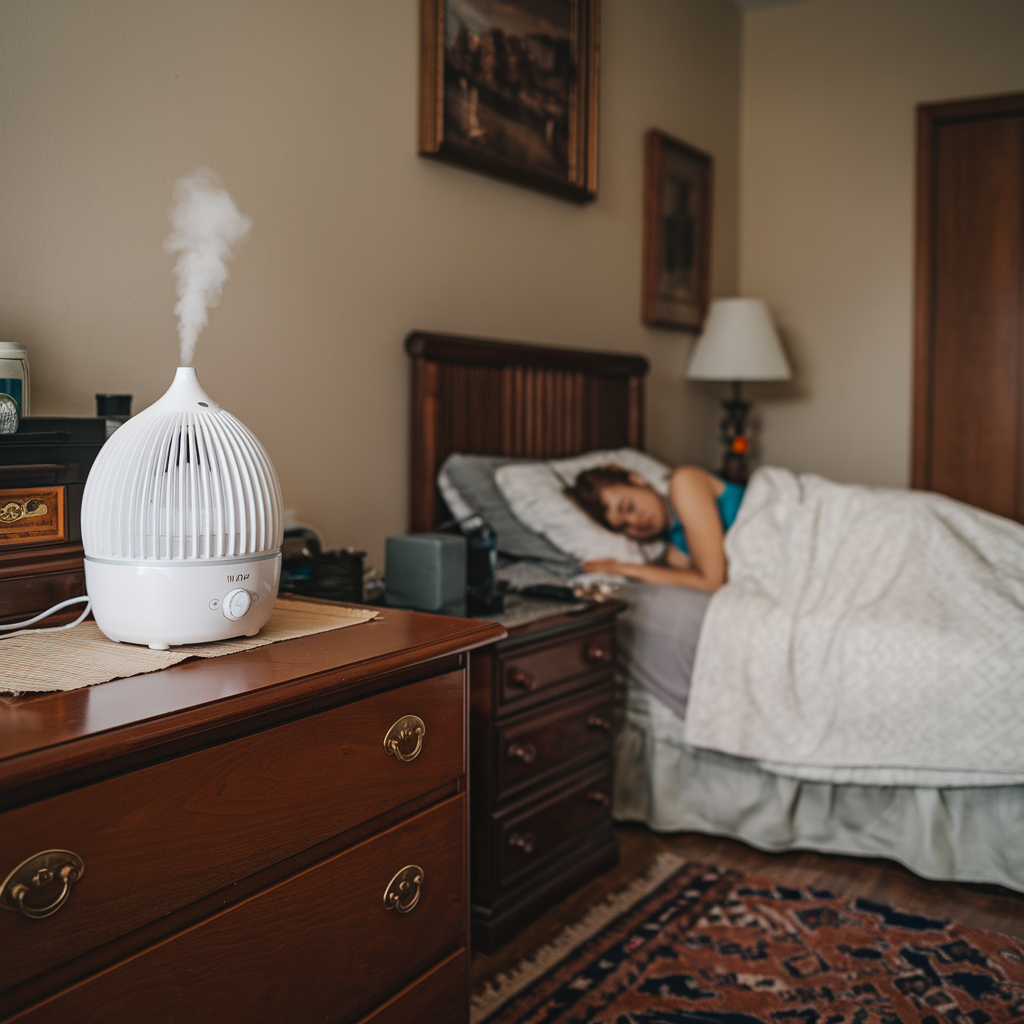Physical Address
304 North Cardinal St.
Dorchester Center, MA 02124
Physical Address
304 North Cardinal St.
Dorchester Center, MA 02124

As I settled into bed after a long day, I often wondered about the little things that could improve my sleep quality. One topic that frequently came up was the use of humidifiers. With dry air affecting our comfort, especially during colder months, I started to explore whether sleeping with a humidifier could make a difference.
Humidifiers promise to add moisture to the air, potentially easing bre
As I settled into bed after a long day, I often wondered about the little things that could improve my sleep quality. One topic that frequently came up was the use of humidifiers. With dry air affecting our comfort, especially during colder months, I started to explore whether sleeping with a humidifier could make a difference.
Humidifiers promise to add moisture to the air, potentially easing breathing and soothing dry skin. But are they really beneficial for sleep? In this article, I’ll dive into the science behind humidifiers, their advantages, and any possible downsides. If you’re looking to enhance your sleep environment, understanding how humidifiers work could be the key to a more restful night.

Humidifiers are devices that add moisture to the air, improving humidity levels in indoor environments. They come in various types, including evaporative, ultrasonic, and steam vaporizers. Each type operates differently, affecting how moisture gets distributed.
Humidifiers benefit health by alleviating dry skin, irritations in nasal passages, and symptoms of allergies. They may reduce respiratory issues, particularly in dry winter months. Maintaining proper humidity levels—typically between 30% and 50%—can promote comfort during sleep, given that dry air often disrupts rest.
However, overuse of humidifiers can lead to excessive moisture, promoting mold growth and dust mites. Regular maintenance, including cleaning and filter changes, is crucial to prevent these issues.
Humidifiers offer several advantages that can improve sleep quality. Their ability to maintain optimal humidity levels contributes to a more comfortable sleeping environment.
Improved sleep quality results from balanced humidity. By adding moisture to the air, humidifiers help reduce dryness in the throat and nasal passages. This reduction leads to fewer disruptions during the night. Studies show that ideal humidity levels, around 40% to 60%, can enhance deep sleep cycles, allowing for restorative rest. Additionally, humidifiers can minimize snoring by keeping the airways moist, promoting uninterrupted sleep for both the user and their partner.
Allergy sufferers benefit significantly from using humidifiers. Increased humidity can ease symptoms associated with nasal congestion, dry eyes, and sinus irritations. By keeping allergens like dust mites and pet dander from becoming airborne, humidifiers create a more pleasant sleeping environment. Incorporating a humidifier during sleep can lead to improved airflow, reducing the chances of waking due to allergic reactions.
Skin hydration improves with proper humidity levels. Humidifiers help retain moisture in the skin, preventing dryness and irritation often exacerbated by dry indoor air. This advantage is especially crucial during winter months when heating systems dry out the air. Maintaining humidity can prevent flakiness and improve overall skin texture, leading to waking up with healthier-looking skin.
While humidifiers offer several benefits for sleep quality, they also present potential drawbacks that warrant consideration. Understanding these issues can help create a balanced approach to using humidifiers.
Excessive moisture in the air can lead to uncomfortable sleeping conditions. Humidity levels above 60% can create a damp environment, encouraging mold growth and dust mites. These allergens can exacerbate respiratory issues and allergies, counteracting the benefits that humidifiers provide. It’s crucial to monitor humidity levels with a hygrometer to maintain an optimal range of 30% to 50%. Taking care of your humidifier and regularly cleaning it also helps prevent excessive moisture from becoming a problem.
Bacterial growth poses a significant risk when using humidifiers at night. If not cleaned regularly, humidifiers can become breeding grounds for bacteria and fungi. These microorganisms can disperse into the air, leading to respiratory problems or infections. To minimize this risk, I clean the humidifier according to the manufacturer’s guidelines and change the water daily. Using distilled water instead of tap water can also reduce mineral buildup and bacteria proliferation, ensuring a healthier sleep environment.
Different types of humidifiers cater to varying needs and preferences, influencing comfort while sleeping. Below are the primary categories to consider.
Cool mist humidifiers release a cool vapor into the air, ideal for adding moisture without raising the temperature. Evaporative models use fans to draw air through wet wicks, naturally humidifying the space while self-regulating humidity levels. Ultrasonic models use high-frequency vibrations to produce a fine mist quietly. Both types benefit allergy sufferers by alleviating congestion and drying out nasal passages. Their operation typically consumes less energy, making them cost-effective for overnight use. Regular cleaning prevents bacteria growth, ensuring a healthier sleeping environment.
Warm mist humidifiers generate steam that cools before exiting the machine. Steam vaporizers heat water to create steam, which can assist with respiratory issues by soothing inflamed airways. These humidifiers can provide a cozy environment during colder months, promoting comfort during sleep. Additionally, some models allow for the addition of medications to relieve cough and congestion. Users must monitor humidity levels, as the warmth can raise room temperatures. Proper maintenance, including regular cleaning, is essential to prevent mineral buildup and bacteria proliferation, promoting safe usage at night.
Using humidifiers can enhance sleep comfort, but safety remains a priority. Following these tips ensures effective use while minimizing any potential issues.
Regular cleaning of humidifiers is essential for maintaining a healthy environment. I clean my humidifier once a week to prevent bacterial growth and mineral buildup. I use a mixture of vinegar and water to eliminate any sediment and disinfect the tank. It’s important to change the water daily to minimize stagnant water, which can harbor bacteria. Additionally, I replace filters according to the manufacturer’s guidelines for optimal performance.
Maintaining optimal humidity levels between 30% and 50% enhances comfort while sleeping. I use a hygrometer to monitor indoor humidity and adjust accordingly. When levels exceed 60%, air can become too damp, leading to mold growth and respiratory issues. I recommend using a built-in humidistat if my model has one, as it automatically regulates humidity. Keeping an eye on these levels ensures a safe and pleasant sleeping environment.
Using a humidifier while sleeping can significantly enhance your sleep quality by maintaining optimal humidity levels. I’ve found that the right humidity can alleviate dryness and promote a more comfortable environment.
However it’s crucial to monitor humidity levels to avoid excess moisture which can lead to mold and respiratory issues. Regular maintenance and cleaning of the device are essential for ensuring a healthy sleeping atmosphere.
If you’re considering a humidifier for your bedroom it’s worth exploring the different types available to find one that suits your needs. With the right approach a humidifier could be a game-changer for your sleep experience.